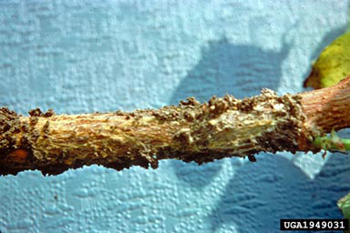PLANT PEST

Chris Anderson, NSW DPI.
Texas root rot
Exotic to Australia
Features: Soil borne fungal disease that causes sudden wilt and death
in many plant species.
Where it’s from: Southwest USA, Mexico, Venezuela, and recently
reported in Libya, North Africa.
How it spreads: Importation of infected plants or soil; local spread
through infected plants, water and soil.
At risk: Thousands of plant species; cotton, grapes, fruit trees, forest
trees, alfalfa, cherry, grains, soybean, lucerne and ornamental plants.
This pest is listed on both the National Priority Plant Pests and the National Priority List of Exotic Environmental Pests, Weeds and Diseases as it has the potential for significant plant industry/agriculture impacts and may also cause significant damage to our environment and social amenity.
Keep it out
Texas root rot, caused by the fungus Phymatotrichopsis omnivor, is one of the most destructive fungal plant diseases. It is a soil-borne fungus that attacks the roots of plants, causing them to wilt and die, usually during the warmer months.
Texas root rot affects over 2000 species of plants including vegetable, fruit and broadacre crops. It is an important disease of cotton as well as grapes, fruit trees and many ornamental plants.
It is very difficult to control Texas root rot once it gets into fields or orchards because it penetrates deep into the soil and survives there for a long time. It has been known to lie dormant for decades, so that only other species that are resistant to the disease can be grown.
Importing goods
To keep Texas root rot out of Australia, never ignore Australia’s strict biosecurity rules.
Import shipments may need to be treated and certified, so before you import, check our Biosecurity Import Conditions system (BICON).
What to look for
- Plants wilting and dying, particularly during hot weather as the rotted roots are unable to take up enough water.
- The roots of infected plants will be covered with a network of white to tan fungal strands.
- In the field, look for patches of dead and dying plants, often with the dead leaves still attached. Patches may expand in a circular pattern during warm weather as the fungus spreads through the soil from plant to plant. You might see a spore mat on the soil around infected plants.

Roots of dead plants are covered in fungal strands.
S.D. Lyda, Bugwood.org.

Dead cotton plants with leaves still attached.
Chris Anderson, NSW DPI.
Where to look
Importers
Infected plants, plant material and soil are the most likely way that Texas root rot could make it to Australia.
Growers and home gardeners
Check plants or crops for wilting and root damage, particularly in summer. It affects agricultural crops like:
- cotton
- grapes, especially Vitis vinifera varieties
- forest trees
- grain crops
- cherry
- mango
- avocado
- corn
- peach
- pecan
- fruit trees
- ornamental plants
What to do
If you think you’ve found Texas root rot:
- take a photo
- do not disturb infected plants (this may be as simple as closing the doors on a shipping container or preventing access to a field).
